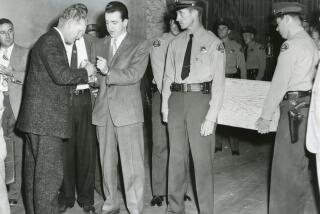Rural Justice for a Man Who Expected None : Native American’s lawyer says that the white jury’s action is a legacy of the ‘60s.
- Share via
Two years ago no one would have bet a dime on it, but on Tuesday a Mendocino jury--seven women and five men--cleared a Native American, Eugene “Bear” Lincoln, on death penalty charges of murdering Sheriff’s Deputy Robert Davis. As Bruce Anderson, editor of Mendocino’s Anderson Valley Advertiser, wrote on the night of the verdict, “130 years ago, Indians in Mendocino County were shot at random, kidnapped, raped, dragged behind horses until they were dead, for fleeing ranch slavery, but today an all-white rural jury said an Indian was innocent of murdering a police officer. Anyone who says we haven’t come a ways hasn’t been paying attention.”
On the night of April 14, 1995, two men died in exchanges of gunfire on a ridge top in Round Valley in eastern Mendocino County, about three hours northeast of San Francisco. One was a Native American, the other a sheriff’s deputy. The surviving Native American, Lincoln, claimed later that he and his companion had no idea who was firing at them, believing their assailants to be another Indian family; Lincoln said that he fired into the darkness in an act of self-defense. As soon as he realized that police officers were involved, he fled for his life.
Though it’s clear that the police killed an Indian, it remains unclear to this day whose bullet killed the deputy. Within an hour, there were as many as 75 police vehicles on the ridge. What ensued was police hysteria, with gunfire pouring down the hill for as long as 45 minutes after the actual fight and a multiagency task force swarming over the little town of Covelo.
Lincoln’s mother had the misfortune to encounter police as she drove along the road. She was pulled from her car and thrown face down on the road, a CHP officer’s boot on the neck of this elderly, arthritic woman. The task force stormed from house to house, bellowing obscenities and terrifying inhabitants. Mendocino County Sheriff James Tuso went on national tabloid TV shows like “America’s Most Wanted,” denouncing Lincoln as “a cop killer” and “very dangerous person.” Such shows regularly depict police breaking into people’s homes, ransacking their possessions in front of their children, with all these appalling breaches of the Bill of Rights offered as prime time docudrama.
In this atmosphere it would not have been surprising to hear of the fugitive Lincoln being cornered and shot to death by a SWAT team without further ado. But he eluded his pursuers and three months later turned himself in at the San Francisco law offices of noted defense attorney Tony Serra. He was charged with four counts of murder, with Mendocino County Dist. Atty. Susan Massini seeking the death penalty.
Things did not look good for Lincoln. The entire county had been inflamed with rabid coverage in the local press, particularly the New York Times-owned Santa Rosa Press-Democrat. The likelihood of a fair trial seemed remote. Since polls showed significant prejudiced opinion against Lincoln, the defense team could have won a change of venue, but feared that the situation in adjoining rural counties could be worse.
The trial ran six weeks, in the course of which Serra established to the jury that the essential case against Lincoln was fatally flawed, indicating at best a case for involuntary manslaughter. On Tuesday, the jury agreed with him on the murder charge and hung 10 to 2 on the question of voluntary or involuntary manslaughter. Lincoln will face a new trial on these counts and is now free on $50,000 bail.
He is not on death row today because he had a fine attorney and a rational jury. So far as the attorney is concerned, if it hadn’t been for the ‘60s, Lincoln probably would not have been so lucky. That radical decade extended legal services to poor people, accustomed in the past to seeing trials take less than a day to send men like Lincoln to the gas chamber.
Lincoln is not on death row today because 12 men and women weren’t drawn from a “lynch ‘em” culture, but one nourished by alternative news sources like the Garberville-based public radio station KMUD and the Anderson Valley Advertiser, which raised serious questions about the case from the start.
These days, the Bill of Rights is under increasing duress. The 4th Amendment is virtually a dead letter and the 6th is headed the same way. Gov. Pete Wilson leads the charge against the very bedrock of our freedom, the jury, which is derided as somehow a barbarous relic.
Lincoln wasn’t lynched. He wasn’t railroaded into the death house. It’s a mile marker in our history that deserves notice, along with reverence for the institutions and laws that saved him.
More to Read
Sign up for Essential California
The most important California stories and recommendations in your inbox every morning.
You may occasionally receive promotional content from the Los Angeles Times.










